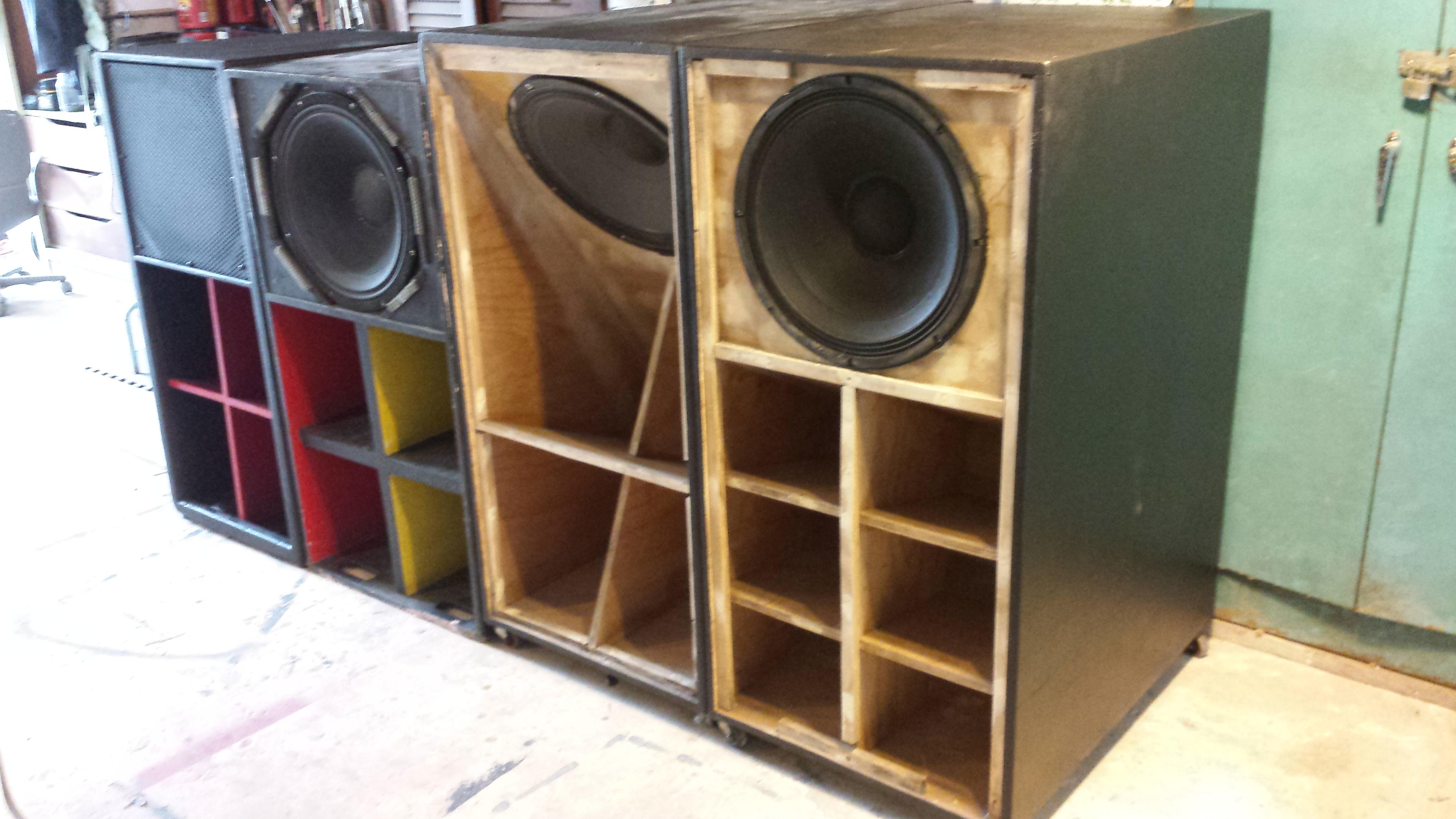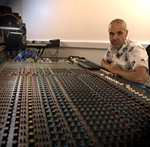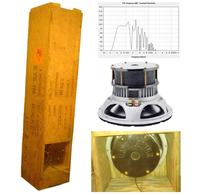- Posts: 305
- Thank you received: 10
How to 'measure' subs
- Reality Sound
-
 Topic Author
Topic Author
- Offline
- Elite Member
-

Less
More
13 years 1 month ago #19081
by Reality Sound
How to 'measure' subs was created by Reality Sound
I have heard conflicting answers in regards to the placement of the RTA MIC. On the floor or at ear level?
Please Log in or Create an account to join the conversation.
- Rog Mogale
-

- Offline
- Premium Member
-

Less
More
- Posts: 120
- Thank you received: 19
13 years 1 month ago #19082
by Rog Mogale
Replied by Rog Mogale on topic Re: How to 'measure' subs
If you only want to do a frequency plot of your subs, then the mic must be on the ground with the element physically touching the ground. The sub cab must also be on the ground and you will need a hard surface like concrete or tarmac to do perform the test. Use a distance of 2 meters from the mic to the front of the sub cab and if its 8 ohms drive with 2.83V. For a 4 ohm load use 2.00V The stimulus should be a swept sine wave from high to low. You will also need to perform this test outside with no wind present and on a very large surface at least 30 x 30 meters to any boundary if it’s going to be at all accurate. If you have a bit of ground larger than 30 x 30 meters then its possible to do the test out at 10 meters with a higher input levels. Although I find this useful I don’t advocate it for real 1w/1m measurements.
If your measuring system is not calibrated then use an accurate SPL meter to calibrate it. You will need to use a Z or linear weighting, or if you only have a C weighting then calibrate at 1kHz. For a linear weighting you could calibrate at say 50Hz as the weighting will not effect the measurement. The above way of testing is called a ground plane measurement and will give you a true 1w/1m frequency plot if your system is well calibrated and you adhere to the 2 meter mic to sub distance. Out of all the free programs available REW V5 or above is well suited to doing swept sine measurements.
If you want to do an RTA of your whole system to perform EQ changes, then the mic must be at ear level, as that’s where we hear from. Use a swept pink stimulus from high to low or constant state pink noise and put the mic where the audience will be. You can move the mic around to get an idea for what the response will be like at different positions around the listening area and adjust so its best overall. A free program like Arta is good for RTA measurements as its relatively fast.
Rog.
If your measuring system is not calibrated then use an accurate SPL meter to calibrate it. You will need to use a Z or linear weighting, or if you only have a C weighting then calibrate at 1kHz. For a linear weighting you could calibrate at say 50Hz as the weighting will not effect the measurement. The above way of testing is called a ground plane measurement and will give you a true 1w/1m frequency plot if your system is well calibrated and you adhere to the 2 meter mic to sub distance. Out of all the free programs available REW V5 or above is well suited to doing swept sine measurements.
If you want to do an RTA of your whole system to perform EQ changes, then the mic must be at ear level, as that’s where we hear from. Use a swept pink stimulus from high to low or constant state pink noise and put the mic where the audience will be. You can move the mic around to get an idea for what the response will be like at different positions around the listening area and adjust so its best overall. A free program like Arta is good for RTA measurements as its relatively fast.
Rog.
Please Log in or Create an account to join the conversation.
- Rog Mogale
-

- Offline
- Premium Member
-

Less
More
- Posts: 120
- Thank you received: 19
13 years 1 month ago #19083
by Rog Mogale
Replied by Rog Mogale on topic Re: How to 'measure' subs
Sorry should be swept pink stimulus from low to high for an RTA measurement. This site won’t let me edit.
Also to get the most accurate way of measuring the input voltage to the driver an impedance test using a 4 wire Kelvin shunt must be taken. This will allow you to see at which frequencies the load really is 8 ohms. Then set a constant sine wave at one of the frequencies that corresponds to 8 ohms and use a DVM to set to 2.83V for an 8 ohm load. Another way to do this with a bit less accuracy, although I still like to check with this, is to replace the driver with an 8 ohm resistor. Make sure you test the resistor first to check its in allowable tolerance of its spec 8 ohms. I like to use 50Hz when testing with a resistor as its kind of half way though the band you are testing. I also check at 20Hz, 100hz and 200Hz with the resistor to see if I’m still around the 2.83v mark. The resistor will not give you the inductive component a real driver has, but if you can’t do an accurate impedance measurement then its better than guessing.
Also to get the most accurate way of measuring the input voltage to the driver an impedance test using a 4 wire Kelvin shunt must be taken. This will allow you to see at which frequencies the load really is 8 ohms. Then set a constant sine wave at one of the frequencies that corresponds to 8 ohms and use a DVM to set to 2.83V for an 8 ohm load. Another way to do this with a bit less accuracy, although I still like to check with this, is to replace the driver with an 8 ohm resistor. Make sure you test the resistor first to check its in allowable tolerance of its spec 8 ohms. I like to use 50Hz when testing with a resistor as its kind of half way though the band you are testing. I also check at 20Hz, 100hz and 200Hz with the resistor to see if I’m still around the 2.83v mark. The resistor will not give you the inductive component a real driver has, but if you can’t do an accurate impedance measurement then its better than guessing.
Please Log in or Create an account to join the conversation.
- Reality Sound
-
 Topic Author
Topic Author
- Offline
- Elite Member
-

Less
More
- Posts: 305
- Thank you received: 10
13 years 1 month ago #19084
by Reality Sound
Replied by Reality Sound on topic Re: How to 'measure' subs
Cheers Rog.
I am attempting to compare several things. One is a BT7 'original servo drive' vs another BT7 cab retrofitted with regular 15" drivers.
Also a regular HOG vs a oversized/extended horn HOG. Plus testing both cabs with different drivers.
Lastly testing an upscaled 4520 with multiple drivers in different 'scoop conditions' being different chamber sizes, and different 'intial horn path size openings'
I am attempting to compare several things. One is a BT7 'original servo drive' vs another BT7 cab retrofitted with regular 15" drivers.
Also a regular HOG vs a oversized/extended horn HOG. Plus testing both cabs with different drivers.
Lastly testing an upscaled 4520 with multiple drivers in different 'scoop conditions' being different chamber sizes, and different 'intial horn path size openings'
Please Log in or Create an account to join the conversation.
- Rog Mogale
-

- Offline
- Premium Member
-

Less
More
- Posts: 120
- Thank you received: 19
13 years 1 month ago #19086
by Rog Mogale
Replied by Rog Mogale on topic Re: How to 'measure' subs
Good luck with all that, it could take a while.
I have to say that in situations like this the pro (ie:expensive) measurement systems make what you are going to do very easy. I have systems that can display up to 100 plots and make labaling and sorting easy. Not sure I would want to do mutiple plots and comparisons on some free software, unless you have a lot of time on your hands.
Please post the plots as it will be good to see whats happening. You might have to experiment with cabinet orientation to get the best from each design. Some might work better horizontal other vertical and some deisgns like the longer horns with compartivley small mouth will need at least 4 hons coupled to get a true idea of there real performance. That will involve a complex and low impedance load that you will have to calculate the input voltage for to keep the tests fair.
I have to say that in situations like this the pro (ie:expensive) measurement systems make what you are going to do very easy. I have systems that can display up to 100 plots and make labaling and sorting easy. Not sure I would want to do mutiple plots and comparisons on some free software, unless you have a lot of time on your hands.
Please post the plots as it will be good to see whats happening. You might have to experiment with cabinet orientation to get the best from each design. Some might work better horizontal other vertical and some deisgns like the longer horns with compartivley small mouth will need at least 4 hons coupled to get a true idea of there real performance. That will involve a complex and low impedance load that you will have to calculate the input voltage for to keep the tests fair.
Please Log in or Create an account to join the conversation.
- Reality Sound
-
 Topic Author
Topic Author
- Offline
- Elite Member
-

Less
More
- Posts: 305
- Thank you received: 10
13 years 1 month ago #19087
by Reality Sound
Replied by Reality Sound on topic Re: How to 'measure' subs
Yeah,.....I do realize I'm going to have to make a day of it. I will be using Smaart_v7 aswell if that helps, but I think I need some sort of preamp between the mic & laptop.
Please Log in or Create an account to join the conversation.
- Rog Mogale
-

- Offline
- Premium Member
-

Less
More
- Posts: 120
- Thank you received: 19
13 years 1 month ago #19088
by Rog Mogale
Replied by Rog Mogale on topic Re: How to 'measure' subs
Uummm, Smaart is good for RTA and real time comparitive RTA during a perfomance, but I'm not aware that its a true measurement based system. Think LMS, Clio, Easera etc for claibrated 1w/1m plots.
I would have a go with REW V5 on the day as well, although you will get pissed off at how slow it is.
And for the original BT7, ha ha I would want to start with a time spectrograph, imuplse response and phase response before I even touch a frequency plot. The real gem will lie in time with a beast like that, not frequency which will just be a by product of its impulse behaviour.
I would have a go with REW V5 on the day as well, although you will get pissed off at how slow it is.
And for the original BT7, ha ha I would want to start with a time spectrograph, imuplse response and phase response before I even touch a frequency plot. The real gem will lie in time with a beast like that, not frequency which will just be a by product of its impulse behaviour.
Please Log in or Create an account to join the conversation.
- Rog Mogale
-

- Offline
- Premium Member
-

Less
More
- Posts: 120
- Thank you received: 19
13 years 1 month ago #19089
by Rog Mogale
Replied by Rog Mogale on topic Re: How to 'measure' subs
And yes you will need a USB preamp between the mic and test computer. It will need 48V phantom powering if you are going to use a serious enough mic to do these tests justice.
Minimum should be the berry measurment mic and something like an M Audio fast track running at 96kHz. Maximum should be a B&K mic with omni capsule and a system 700 from Linear X.
More serious systems don't use external preamps. They come with ISA slot mounted boards that have all A/D & D/A connectons self contained. That way devices like accelorometers and LCR functions can be ultilsed. But expect mortgage like sums for these systems.
Minimum should be the berry measurment mic and something like an M Audio fast track running at 96kHz. Maximum should be a B&K mic with omni capsule and a system 700 from Linear X.
More serious systems don't use external preamps. They come with ISA slot mounted boards that have all A/D & D/A connectons self contained. That way devices like accelorometers and LCR functions can be ultilsed. But expect mortgage like sums for these systems.
Please Log in or Create an account to join the conversation.
- Reality Sound
-
 Topic Author
Topic Author
- Offline
- Elite Member
-

Less
More
- Posts: 305
- Thank you received: 10
13 years 1 month ago #19090
by Reality Sound
Replied by Reality Sound on topic Re: How to 'measure' subs
Ahhh....Rog sounds like you have all the toys. Tell you what,......you bring all the gear needed for this here (Bermuda) and I'll put you up for a few days. I'm sure you need a vacation. 
Please Log in or Create an account to join the conversation.
- Dref
-

- Offline
- Premium Member
-

Less
More
- Posts: 96
- Thank you received: 1
13 years 1 month ago #19091
by Dref
Replied by Dref on topic Re: How to 'measure' subs
RS, You had a measurement mic with a built in USB sound card right?
So the only problem could be that your output (The sound card of your laptop) might not be sufficient?
But it is probably just fine.
Rog, The 2m in 2pi is to equate 1m in 4pi right?
The setup I use at the moment consist of a Presonus Firebox sound card, a Samson Servo 120a amplifier and Superlux ECM999 or IMG Stage Line ECM-40 Measurement Mic.
I also have a SPL meter with the ability to select flat weighting and a AC voltmeter which I use when I make 1W/1m measurements. (But their calibration is not up to date..)
Most of the measurements I have done so far have been 1W/1m 2Pi.
So the only problem could be that your output (The sound card of your laptop) might not be sufficient?
But it is probably just fine.
Rog, The 2m in 2pi is to equate 1m in 4pi right?
The setup I use at the moment consist of a Presonus Firebox sound card, a Samson Servo 120a amplifier and Superlux ECM999 or IMG Stage Line ECM-40 Measurement Mic.
I also have a SPL meter with the ability to select flat weighting and a AC voltmeter which I use when I make 1W/1m measurements. (But their calibration is not up to date..)
Most of the measurements I have done so far have been 1W/1m 2Pi.
Please Log in or Create an account to join the conversation.
Time to create page: 0.274 seconds